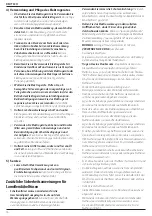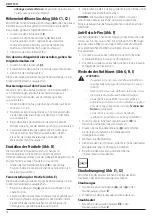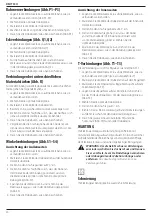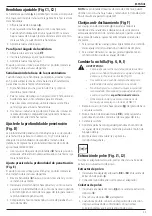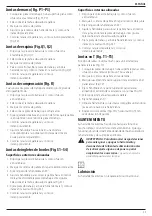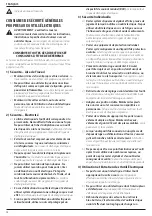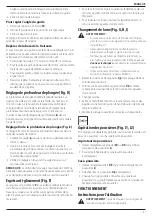
28
EngLIsh
Protecting the Environment
w
Separate collection. Products marked with this symbol
must not be disposed of with normal household waste.
Products contain materials that can be recovered or
recycled reducing the demand for raw materials. Please
recycle electrical products according to local provisions. Further
information is available at
www.2helpU.com
.
Optional Accessories
WARNING:
Since accessories, other than those offered
by PROTO
D
e
WALT
, have not been tested with this
product, use of such accessories with this tool could be
hazardous. To reduce the risk of injury, only PROTO
D
e
WALT
recommended accessories should be used with
this product.
Consult your dealer for further information on the
appropriate accessories.
D
Cleaning
WARNING:
Blow dirt and dust out of the main housing
with dry air as often as dirt is seen collecting in and around
the air vents. Wear approved eye protection and approved
dust mask when performing this procedure.
WARNING:
Never use solvents or other harsh chemicals
for cleaning the non-metallic parts of the tool. These
chemicals may weaken the materials used in these parts.
Use a cloth dampened only with water and mild soap.
Never let any liquid get inside the tool; never immerse any
part of the tool into a liquid.
C
Lubrication
Your power tool requires no additional lubrication.
MAINTENANCE
Your power tool has been designed to operate over a long
period of time with a minimum of maintenance. Continuous
satisfactory operation depends upon proper tool care and
regular cleaning.
WARNING:
To reduce the risk of serious personal
injury, turn tool off and disconnect tool from power
source before making any adjustments or removing/
installing attachments or accessories.
An accidental
start-up can cause injury.
Edge Mitre Joints (Fig. S1–S4)
Outside surfaces aligned
1. Arrange the workpieces as they are to be assembled.
2. Mark the biscuit centres on the outside of the joint.
3. Set the fence angle to 90 °.
4. Adjust the fence to locate the biscuit toward the inside
of the joint where the workpiece is thicker. Select the
appropriate biscuit size (Fig. S2).
5. Clamp the workpiece and align the tool as shown (Fig. S3).
6. Cut the biscuit slots as described above.
Inside Surfaces Aligned
1. Arrange the workpieces as they are to be assembled.
2. Mark the biscuit centres on the inside of the joint.
3. Set the fence angle to 45 °.
4. Adjust the fence to locate the biscuit toward the inside
of the joint where the workpiece is thicker. Select the
appropriate biscuit size.
5. Clamp the workpiece and align the tool as shown (Fig. S4).
6. Cut the biscuit slots as described above.
T-Joints (Fig. T1–T5)
This type of joints is commonly used to attach shelves to side
panels (Fig. T1).
1. Place the workpieces on a flat surface as they are to be
assembled (as an upside down T).
2. Mark the biscuit centres on the shelf piece.
3. Lightly mark the top of the shelf on the side panel (Fig. T2).
4. Clamp the fence on top of the side panel, aligning the end
of the shelf with the line (Fig. T3).
5. Select the appropriate biscuit size.
6. Set the fence to 0 °.
7. Align the tool with the biscuit marks using the markings on
the tool base.
8. Make a vertical (Fig. T4) and a horizontal (Fig. T5) cut at each
of the biscuit locations.
Summary of Contents for DW682
Page 1: ...DW682 ...
Page 3: ...1 Fig A 3 4 10 9 5 17 2 8 7 11 6 1 ...
Page 4: ...2 Fig B Fig C1 Fig C2 Fig D Fig E Fig F Fig G Fig H 2 1 11 6 9 4 8 6 7 12 ...
Page 6: ...4 5 7 5 cm 15 25 cm 15 25 cm Fig M4 Fig N Fig O1 Fig O2 Fig P1 Fig P2 Fig P3 Fig Q1 ...
Page 7: ...5 Fig Q2 Fig R Fig S1 Fig S2 Fig T1 Fig T2 Fig S3 Fig S4 ...
Page 8: ...6 Fig T3 Fig T4 Fig T5 Fig U 3 16 ...
Page 106: ......
Page 107: ......



